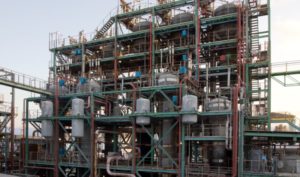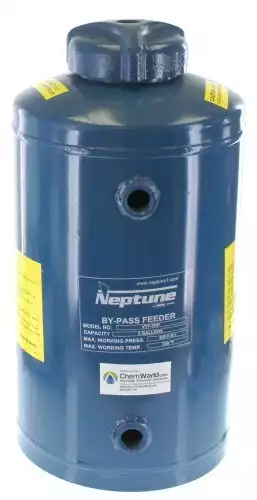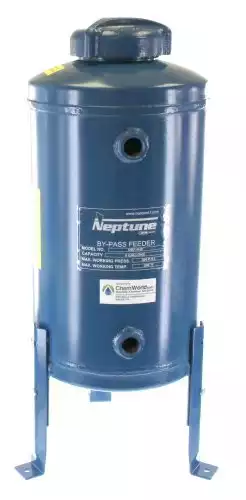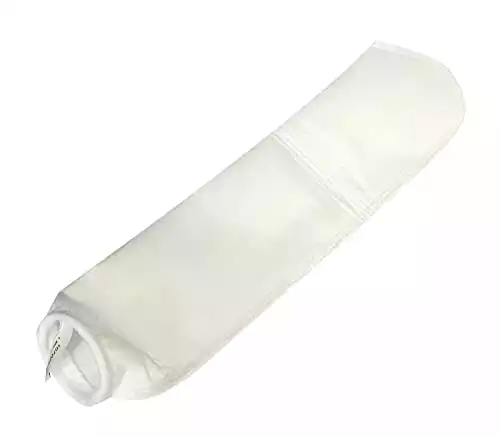3 Things to Keep in Mind For Single Loop Water Systems
A chemical pot feeder is a device that automatically dispenses chemicals into a closed water system.
You’ll find them in a variety of heating or air conditioning systems and combustion engines. Often they’re employed to mitigate against corrosion or to resolve different types of contamination that might seep into the water from other components of the system.
Similar tank-based chemical feeders are also used in less industrial operations like swimming pools for regulation of pH and Chlorine levels.
In this article, we’ll discuss how they work, what you should look for when selecting one, and sizing considerations.
There are two types of chemical pot feeders: single loop and dual loop. The information you’ll find below is most relevant to single-loop water systems.
How does a chemical pot feeder work?
Most chemical pot feeders have an inner container where the chemical is held, and an outer shell that water circulates through.
The inner container is typically porous, and often fitted with a filter bag. Commonly, the size of the openings are measured in microns.
As water flows through the system, chemical from the inner “pot” dissolves and circulates as part of normal operation.
Most of the time, chemical pot feeders are located on a secondary loop which runs alongside the primary operation loop of the sytem.
How do you use a chemical pot feeder?
Depending on the chemical you’re adding and the desired rate of introduction you might expect the addative to be in either a liquid, powder, or tablet form. This will be added manually while the tank is isolated and depressurized.
Some models can be isolated with a bypass, while others are piped inline with the water supply. You may have a designated pressure release valve, or be able to depressurize by opening the outflow line.
Some chemical pot feeders come with a valve that automatically dispenses chemical into the water system when the level is too low.
What should you look for when buying a chemical pot feeder?
Every system is different, but in general you should look for chemical pot feeders that are made of corrosion-resistant materials, have chemical activation sensors, and adjustable chemical release.
We also recommend chemical pot feeders with a float valve for single-loop water systems.
Here are a few more tips on sizing your feeder, installing and maintaining it.
Sizing
The chemical pot feeder must fit your system’s specifications. Selecting the correct size primarily depends on two factors.
The first is chemical feed rate.
The second is water flow rate, which is measured in gallons per minute (GPM).
If the chemical pot feeder is smaller than the chemical flow rate, it will overflow. If the pot feeder is too large for your water flow rate, chemical feed rate will be reduced.
Orientation
Depending on the make and model of your chemical pot feeder, the inlet and outlet ports may be oriented in a different fashion on the tank.
This means that the direction of water flow may go from bottom to top, top to bottom, or across the belly of the tank from one side to the other.
This is worth planning, as the orientation may have an impact on how easy the device is to install with your existing water system.
Installation
In most cases, it’s worthwhile to have a pro install your chemical pot feeder.
Some chemical pot feeders will require a T or Y-valve for installation purposes. These feeders will have a valve built into the system.
Other chemical pot feeders require an additional chemical pump to be installed in your chemical feed line. Once chemical pot feeder is installed in the chemical system, you’ll want to adjust chemical flow rate for desired results.
Filters
One of the most important factors to keep chemical pot feeders working properly is filter replacement.
In addition to helping with the metered release of chemical into the system, the feeder’s filter will help to prevent chemical particles from clogging pumps and other components in your water system.
If chemical pot feeder filters are not replaced periodically, you may pass sediment into the system or generate a blockage.
Personal Protective Equipment (PPE)
Based on the purpose of your system, and the chemicals you’ll be working with, be sure to equip yourself with the appropriate PPE before using.
For many applications that means protective gloves, clothing, and footwear. In almost all cases you’ll need safety goggles or a face shield.
Even when you’re using the equipment correctly, it’s important to outfit yourself with the right protective gear. Take time to study the safety requirements of your device.
What chemical pot feeders do you recommend?
Choosing the right chemical pot feeder really depends on your intended application.
We like Neptune’s filter-feeder models, which allow filtration to be done at the same stage as chemical additives.
The Neptune Filter Feeder combines chemical addition and high capacity filtering in one piece of equipment. The Neptune VTF-5HP Chemical Feeder features a 4" wide mouth and 5-gallon capacity.
Neptune chemical pot feeders are available in a variety of tank capacities, mostly between 2-10 gallons. All models are rated for max pressure of 300 psi at 200 Farenheit. Weights are in the 20-40lb range, depending on the model and sizing you select.
The Neptune Filter Feeders are a convenient way to introduce solid or liquid chemicals into hot or cold water closed circulating systems. The Neptune DBF-5HP Chemical Feeder features a high-pressure cap rated to 300 psi (20.7 bar) as a standard.
Their stainless steel filter basket is easily removable, and can be outfitted with 1-50 micron ring-top filter bags.
The Neptune Pump Filter Bags are available for all “VTF” and “DBF” models up to 10 gallons. The addition of a filter bag allows the By-Pass Feeder to function simultaneously as a side stream filter.
Most models are compatible with Neptune’s leg extensions, which makes it easy to orient the drain valve over a safe drain or outlet line.





